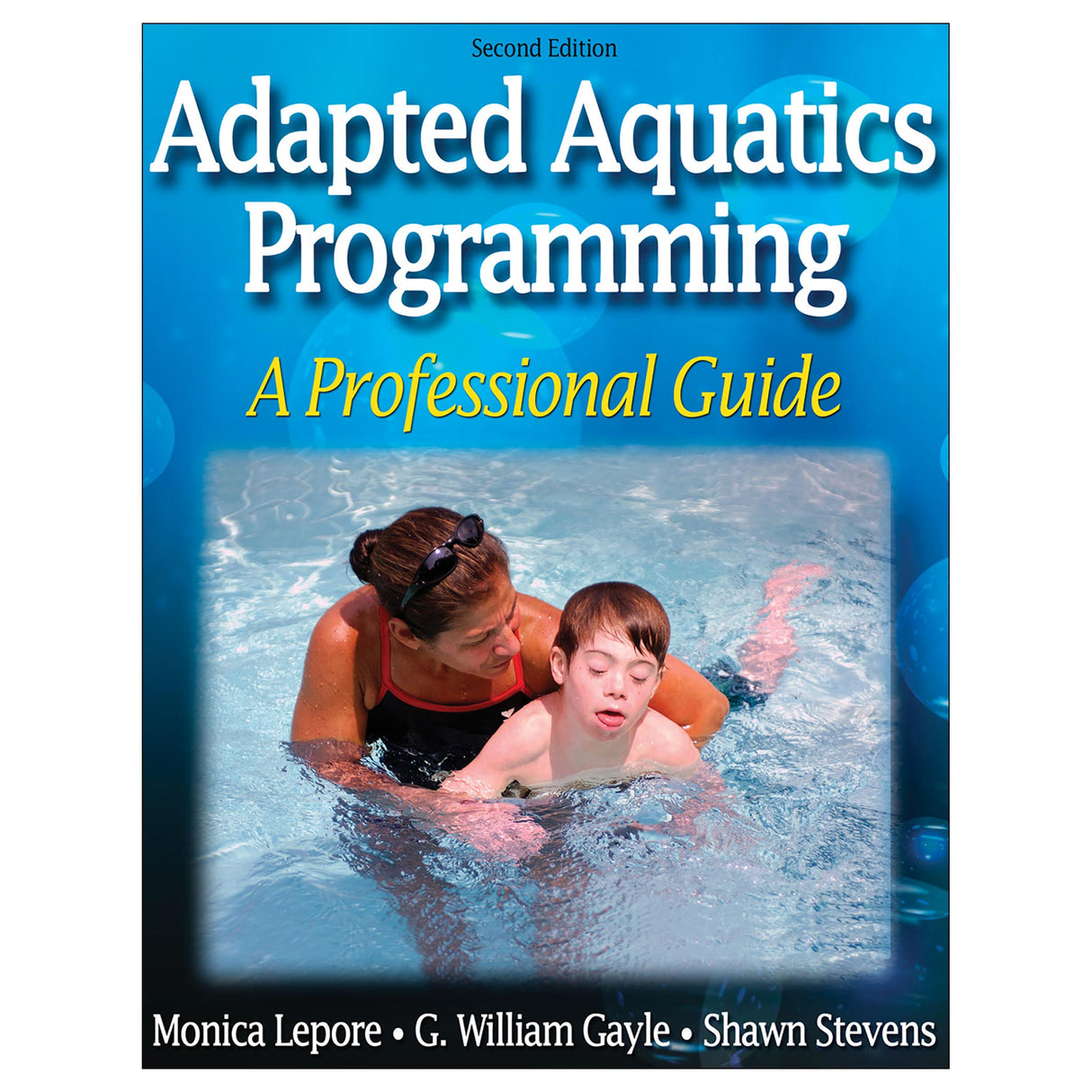Adapted Aquatics Programming-2nd Edition
A Professional Guide
$39.00 CAD
The second edition of Adapted Aquatics Programming: A Professional Guide
-clarifies rationales for adapted aquatics programming,
-broadens the scope of and enriches traditional programs for people with disabilities,
-guides instructors in improving teaching methods and safety management, and
-educates professionals on providing safe and effective adapted aquatics programs.
The second edition of Adapted Aquatics Programming: A Professional Guide is packed with new material, including up-to-date information on relevant legislation, guidelines on architectural accessibility, instructional strategies, equipment, safety management, and competitive and recreational aquatics activities.
This comprehensive resource is a significant addition to the aquatics literature, providing a practical learning tool for the field. The authors infuse each chapter with specific techniques as well as rationales for adapted aquatics programming. They also provide readers with
-best practices in adapted aquatics programming,
-a description of the scope of traditional adapted programs with enrichment ideas,
-guidance in improving teaching methods and safety management, and
-instruction in providing safe and effective adapted aquatics programs.
Adapted Aquatics Programming, Second Edition, contains a wealth of references, practical tips, and safety precautions. It includes a number of new features, including photographs and diagrams, life-experience scenarios that provide a reference point for the chapter ahead, and an objectives list for each chapter. It also offers ideas for using equipment and includes information about competitive and recreational aquatics activities.
In part I, the authors explore foundational issues of adapted aquatics, including models of collaboration, inclusion, planning, program development, facilities, equipment, and supplies. In part II they lay out instructional strategies and detail how to build safe and effective programs. They also look at the specific needs of program participants and issues related to aquatic fitness and rehabilitation. In part III they provide information on enhancing a program conducting competitive and recreational activities.
Founded on action-based research and current thinking, laws, and practices, Adapted Aquatics Programming, Second Edition, offers a practical approach to adapted aquatics, providing much-needed information on adapting the environment, equipment, instructional strategies, skill techniques, and teaching methods for people with disabilities. This text fills the need for a source of current best practices in adapted aquatics programming.
Audience
Text for adapted aquatics instructor courses. A reference for instructors of adapted aquatics professionals who teach or coach in inclusionary aquatics programs and others who teach swimming or manage aquatics programs.
Preface
Acknowledgments
Part I. Foundations of Adapted Aquatics
Chapter 1. Introduction to Adapted Aquatics
Evolution of Adapted Aquatics
Legislation for Individuals With Disabilities
Benefits of Aquatics Participation
Applications of Aquatics Participation
Summary
Chapter 1 Review
Chapter 2. Models of Collaboration in Adapted Aquatics
Models for Adapted Aquatics
Medical-Therapeutic Model
Educational Model
Recreation Model
Transdisciplinary Model
Summary
Chapter 2 Review
Chapter 3. Inclusion and the Least-Restrictive Environment
Placement, Inclusion, and the LRE
Continuum of Placements
Prerequisites to Successful Inclusion
Developing and Maintaining Successful Inclusion Groups
Using Activities to Facilitate Inclusion
Summary
Chapter 3 Review
Chapter 4. Individualized Instructional Planning
Planning for Assessment
Developing the IEP or IAPP
Implementing the IEP or IAPP
Summary
Chapter 4 Review
Chapter 5. Program and Organization Development
Organizational Foundations
Communications and Promotion
Financial Development
Facilities Acquisition
Risk Management
Program Development and Evaluation
Human Resource Management
Summary
Chapter 5 Review
Chapter 6. Facilities, Equipment, and Supplies
Facilities
Equipment and Supplies
Summary
Chapter 6 Review
Part II. Facilitating Instruction
Chapter 7. Prerequisites to Safe, Successful, and Rewarding Programs
Essential Communication Skills
Transferring Techniques
Participant Care and Safety
Hydrodynamics
Positioning and Supporting Participants
Summary
Chapter 7 Review
Chapter 8. Instructional Strategies
The Learning Process
Teaching, Facilitating, and Guiding Participants
Addressing Problem Behaviors
Summary
Chapter 8 Review
Chapter 9. Specific Needs of Adapted Aquatics Participants
Definitions of Common Disabilities in Adapted Aquatics
Commonly Seen Attributes of Learners in Adapted Aquatics
Atlantoaxial Instability
Attention Deficit
Auditory Perception Disorder
Autonomic Dysreflexia or Hyperreflexia
Balance Disorder
Brittle Bones
Cardiovascular Disorder
Circulatory Disorder
Contractures and Limitations to Range of Motion
Hearing Loss: Deafness and Hard of Hearing
Hearing Loss: Deafblindness
Head Control Difficulty
High Muscle Tone
Hyperactivity
Interaction Difficulty
Joint Dysfunction
Kinesthetic System Disorder
Memory and Understanding Difficulty
Multisensory Loss
Oral Motor Dysfunction
Paralysis, Paresis, and Atrophy
Posture Disorder
Primitive Reflex Retention
Proprioceptive Disorder
Range of Motion Dysfunction
Receptive or Expressive Language Disorder
Respiratory Disorder
Seizure Disorder
Tactile System Disorder
Temperature Regulation Disorder
Vestibular System Disorder
Visual Impairment
Visual Perception Disorder
Summary
Chapter 9 Review
Chapter 10. Aquatic Fitness and Rehabilitation
Health-Related Physical Fitness and Aquatic Exercise
Physical Conditions and Tips for Aquatic Rehabilitation
Summary
Chapter 10 Review
Part III. Program Enhancement
Chapter 11. Adapted Aquatics Program Selection
Program Environments
Program Purpose
Types of Participation
Nationally Sponsored Adapted Aquatics Programs
Summary
Chapter 11 Review
Chapter 12. Competitive and Recreational Activities
Effect of Legislation on Aquatics Participation
Competitive Swimming for Individuals With Disabilities
Equitable Competition and Classification
Coaching Swimmers With Disabilities
Recreational Aquatic Activities
Summary
Chapter 12 Review
Appendix A Adapted Aquatics Position Paper of the Aquatic Council: AAALF and AAHPERD
Appendix B Assessment Forms
Appendix C Games and Activities for Various Age Groups
Appendix D Information-Gathering Forms
Appendix E Adapted Aquatics Program Resources
Appendix F AAPAR Levels of Adapted Aquatics Credentials
Glossary
References
Index
About the Authors





